 |
Picks is a monthly sampling of Japan's art scene, offering commentary by a variety of reviewers about exhibitions at museums and galleries in recent weeks, with an emphasis on contemporary art by young artists. |
 |
 |
|
|
 |
 |
|
| Takao Inoue and Kazuma Makino: Something We Can't See |
| 8 - 31 August 2013 |
Matsuo Megumi + Voice Gallery pfs/w
(Kyoto) |
 |
| This dual show paired a veteran photographer with one in his thirties. Inoue and Makino share a penchant for familiar scenes and undramatic natural landscapes, but in their simple, direct approaches to the subject one can detect each artist's unique eye and sense of time. As the title suggests, there is something invisible lurking in their work, which is at the same time refreshingly evocative. |
|
|
 |
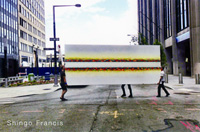 |
 |
|
| Shingo Francis: Across the Line: a voyage into the void |
| 8 - 24 August 2013 |
Galerie Paris
(Kanagawa) |
 |
| From blue-tinged, nearly monochromatic color-field paintings, U.S.-based Francis has recently shifted toward works featuring bands of color stretching across broad canvases. In the large composition Into Space, featured in this recent Yokohama show, a thick white line horizontally bifurcates the canvas with an iterative multicolored pattern extending above and below it. |
|
|

|
 |
 |
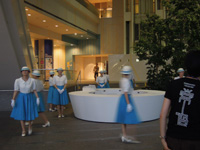 |
 |
| Miwa Yanagi: The Attendant Project |
| 8 - 11 August 2013 |
Aichi Arts Center
(Aichi) |
 |
| Photographer Miwa has often used elevator girls or usherettes as a recurring motif. Her performance work at Aichi Triennale 2013 resonates with concurrent projects like Katsuhiro Miyamoto's Fukushima Dai-ichi Sakae Nuclear Plant (which proposes installing a reactor in Nagoya's downtown Sakae district) and includes a radio drama that was broadcast as part of Japan's propaganda effort vis-à-vis U.S. troops after the atomic bombings. An assemblage of themes that dovetail with the August anniversary of the war's end, Zero Hour: Tokyo Rose's Last Tape transcends time and space. |
|
|
 |
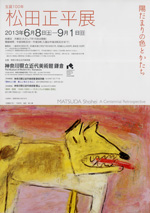 |
 |
| Matsuda Shohei: A Centennial Retrospective |
| 8 June - 1 September 2013 |
|
The Museum of Modern Art, Kamakura
(Kanagawa)
|
 |
| One of Japan's most celebrated postwar painters, Shimane-born Matsuda (1913-2004) was hailed by critics like Toru Sunouchi for works with "a surface texture of unparalleled beauty." Other paeans quoted on the flyer for this exhibition (shockingly, Matsuda's first major retrospective in the Tokyo area) include "elusive," "savory," and "a rich poetic sensibility that is at once witty and rigorous." |
|
|
|
|
|
|
|

|
 |
 |
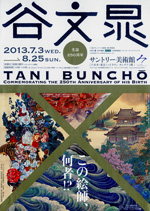 |
 |
| Tani Buncho: Commemorating the 250th Anniversary of His Birth |
| 3 July - 25 August 2013 |
Suntory Museum of Art
(Tokyo) |
 |
| Literati (bunjin) painter and poet Buncho (1763-1841) might be called the quintessential premodern postmodernist. With an eclectic oeuvre that personified the diversity of Edo-era painting, Buncho mastered all the major styles of the day, making himself a bit of a rule-breaker by the rigid standards of feudal Japan's artistic milieu. As this retrospective demonstrated, his repertory spanned the Kano, Tosa, and Maruyama Shijo schools as well as Chinese and Western painting, genres that he moved among with the utmost alacrity. |
|
|
 |
 |
| Tomoe Murakami: This Ultimate Transparent Place |
| 20 August - 20 September 2013 |
G/P gallery
(Tokyo) |
 |
| Since her 2004 debut, photographer Murakami has consistently focused on landscapes. Whatever vicissitudes she may have personally experienced, to an outsider she appears to have followed a smooth and sure career path, producing work that reveals an ever-broadening and -deepening point of view. This, her first solo exhibition, featured new works that won her the Foam Talent prize from the Netherlands-based photography journal Foam Magazine. |
|

|
 |
 |
 |
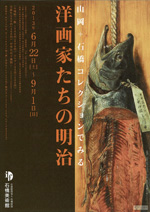 |
|
| The Meiji Period Depicted by Western-style Painters |
| 22 June - 1 September 2013 |
Ishibashi Museum of Art
(Fukuoka) |
 |
| The recently renovated Ishibashi assembled this selection of some 150 Meiji-era Western-style paintings (yoga) from the Yamaoka and Ishibashi Collections. Included were works by Kyushu favorite sons like Shigeru Aoki. Divided into eight themes -- education, overseas study, Japan's exhibition system, and so on -- it offered a comprehensive look at a generation of artists attempting to absorb an entire set of new rules and techniques at a turning point in Japan's cultural history. An entertaining touch was provided by intriguing episodes from the artists' lives. |
|
|
 |
 |
 |
| Yusuke Iguchi + Reiko Matsumoto + Mariko Mukumoto |
| 5 - 25 August 2013 |
Rise Gallery
(Tokyo) |
 |
| This opening installment of the gallery's ongoing series "Creativity Continues 2013-2014" introduced three artists with rather disparate oeuvres. Iguchi offered a gargantuan plywood parabolic antenna replete with blueprints and sketches; Matsumoto displayed a series of wildly impressionistic watercolors on paper; and Mukumoto installed large sculptures that treat water as a solid object. Over the coming year the artists will take turns filling the space with their own solo shows. |
|
|
|
|
|
|
 |
 |
| Koji Inoue: Soundless Memories |
| 20 August - 1 September 2013 |
Art Galley
(Tokyo) |
 |
| From 1955 on, Inoue (1919-93) ran a camera shop in his hometown of Fukuoka while pursuing his own muse as a photographer. Rendered deaf in a childhood accident, Inoue more than compensated by developing an acuity of eye remarkable even for his profession. That keen vision is manifested in snapshots that evince a nimble yet gentle approach to his subjects, one that continues to draw viewers to his work. |
|
 |
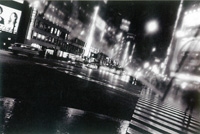 |
 |
| Yuichiro Tanaka: Atlas Black |
| 24 August - 22 September 2013 |
photographers' gallery
(Tokyo) |
 |
| "Atlas Black" is a series of 24 monochrome snapshots taken in Tokyo and its environs between 2006 and 2009. If the images impart a sense of déjà vu, it is because they are smack in a lineage of gritty urban street scenes that extends unbroken from the late-sixties work of Daido Moriyama, Takuma Nakahira, et al. Nothing wrong with revisiting one of the golden ages of Japanese photography, but this reviewer looks forward to a fresh perspective in Tanaka's newer work, which includes color snapshots and scenes of Brazil. |
|
|
|
|
 |
|